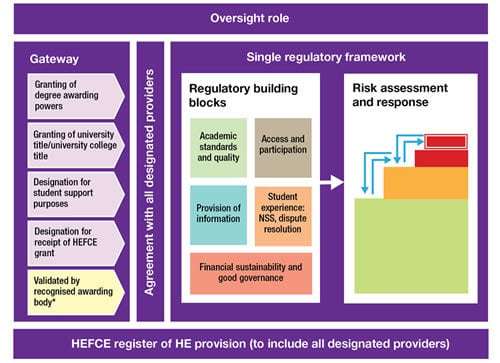The recent movement of teaching funding from public grants to student fees has triggered a wider discussion on reform of the higher education regulatory system in England. As such, many different bodies and organisations have considered the question of regulatory reform.
In December, the Higher Education Better Regulation Group published a brief history of developments to date (see annexe 3). The Regulatory Partnership Group, including the sector’s regulators and agencies, generated the diagram below to capture how existing legislation and regulation applies to the growing sector.
The Higher Education Commission, the Higher Education Policy Institute and the Institute for Public Policy Research have all published papers on what direction higher education regulation in England should take in the future. Although there is no shortage of thinking on this issue it is unlikely to be resolved before the 2015 general election. With Coalition all but finished developing serious new legislation, most assume that it will fall to a new government in the next Parliament to introduce a new Higher Education Act for England.
Despite the surfeit of writing on the future of English higher education regulation, a fundamental question remains: should a new English higher education regulatory system have one set of rules for all or should different rules apply for different types of provider? This is not an inconsequential question.
As it continues to evolve, the higher education sector in England is becoming unrecognisably diverse. It includes every imaginable variation of higher education provider along a spectrum ranging from HEFCE-funded charities (the ‘traditional’ higher education institutions, including universities) to for-profit ‘new entrants’, also known as ‘independent’ or ‘alternative’ providers. Policy makers and sector agencies are going to need to decide between a single regulatory system that applies to all provider types or tiered regulatory systems specially designed for categories of higher education providers.
Tiered regulatory systems
There are a number of reasons why some would prefer tiered regulatory systems. The English higher education sector is currently subject to a bifurcated regulatory system, with HEFCE (by and large) regulating the traditional providers and the Department of Business Innovation and Skills regulating new entrants.
One may also suggest that the differences between higher education providers make it impossible to properly regulate all providers with one set of rules: regulation for untested new entrants will be unnecessarily burdensome for traditional providers but regulation for traditional providers will not be rigorous enough for new entrants.
Different regulatory regimes can also provide the opportunity to segregate and isolate problem areas within the sector.
A single set of rules
There are clear advantages to having a single set of rules for the entire English higher education sector. Students can be assured that the same thresholds and expectations are applied to all higher education providers, regardless of provider type or business model. A tiered model, with different expectations for different provider types, increases the cost of regulation to the public and the sector, reduces transparency and can undermine student confidence in the sector as a whole. Finally, a single regulatory model offers the opportunity for better sharing of data across the sector as a unified whole, which can reduce regulatory burden and help ensure regulators are more sensitive to change.
However, a single regulatory architecture does pose its own challenges. Foremost among these challenges is ensuring that the architecture is elastic enough to appropriately and proportionately capture the diversity of the English higher education sector. There are two essential elements required of a single regulatory architecture for it to work properly:
1. Equitable, rather than equal, application of regulation. The application of regulation should reflect the nature, behaviour and performance of individual providers. Equal application of regulatory requirements translates into costly and unnecessary intrusion into the operations of some providers or misses threats to the health of the sector by not having the right kind of oversight.
Equitable regulation allows regulators to consider the necessary level of oversight of a provider’s operations based on factors such as the strength of its institutional governance processes, demonstration of forward planning, and sophistication of an institution’s performance indicators. Regulation can ensure expectations are being met without treating all institutions the same.
2. Applying the principle of ‘explain or comply’ to regulation. Building on an equitable approach to regulation, it is essential for future regulators to employ the ‘explain or comply’ principle already used by HEFCE in other areas of regulation.
Regulation should be designed to meet articulated public policy objectives. The policy objectives should drive regulation, not vice versa. And there is always more than one way to skin a cat. If an institution demonstrates it can meet policy objectives through other means there is little reason for a regulator to dictate a particular process or practice be pursued. Applying the principle of ‘explain or comply’ means that institutions are permitted the opportunity to explain how their current practice meets or exceeds the objective of regulatory requirements. If institutional practice does not meet or exceed a regulatory requirement, the provider may be required to comply with the program outlined by the regulator.
David Willetts has often pointed to the autonomy of the British higher education sector as a contributing factor in the UK’s historic research success and strong position in the global higher education market. There is broad consensus amongst the major political political parties about this idea and so the next government is unlikely to have a radically different notion of institutional autonomy, although it can be nuanced.
Regulation can uphold and support the autonomy of higher education providers while employing a single regulatory system for the English higher education sector. The principals of equity and ‘explain or comply’ will increase the complexity of any future regulatory system, but they can also improve the sensitivity of regulation and reduce cost to the sector and the public in the long run.
Whichever party wins the General Election next year will need to seriously grapple with these ideas as they design a future regulatory system and prepare legislation to uphold it.














One of the things that Andrew reflects is the old tension between regulation and institutional autonomy. In almost all debates about regulation, “autonomy” is either held up as a good in itself or as something that has somehow caused success in a given industry.
I like to think of ‘autonomy’ as ‘freedom’- as in, “What should institutions/organisations/companies people be free to do”, so we can assess along the old “freedom from/freedom to” axis. So for example, I don’t think that an institution should be free to run a terrible. I do think that institutions should be free beyond a minimum standard to have differing academic standards applied to the entry of students and their qualifications.
I do think that institutions should be free to set their own internal complaints procedures. I don’t think that that those procedures should take 24 months and only feature actors institutionally and defensively loyal to their HEI.
I do think that that institutions should be free to set their own charges for photocopying. I don’t think that institutions should be free to charge a fee without setting out what a student gets for that fee in terms of teaching, facilities, assessment and… er… photocopying.
Really helpful primer on an important topic. Thanks Andrew.
Thanks Andrew. You have given a clear overview of a policy issue that requires an objective “360 degree” examination to have integrity. In a diverse higher education sector such an issue cannot be resolved by examination through the lens of a single type of organisation, with its particular interests and challenges. And a modern 21st century economy/society has to have a diverse landscape of providers to meet its requirements – no one type of university can meet all its needs.
Your point that sector diversity dictates the need for the equitable application of regulation, rather than equality of application, is fundamental to sustaining quality and hence the reputation of our university sector. Further, the principle of “comply or explain” in regulatory matters provides flexibility whilst not diluting responsibility – it encourages innovation but retains accountability. Good article Andrew.
Nice